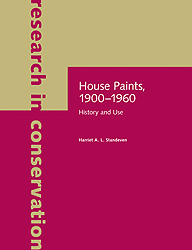
Harriet A. L. Standeven; 2011
Read Online
Download PDF
Purchase a Copy
Find in WorldCat
The versatility of modern commercial house paints has ensured their use in a broad range of applications, including the protection and decoration of historic buildings, the coating of toys and furniture, and the creation of works of art. Historically, house paints were based on naturally occurring oils, gums, resins, and proteins, but in the early twentieth century, the introduction of synthetic resins revolutionized the industry. Good quality ready-mixed products became available and were used by artists worldwide.
While the ubiquity of commercial paints means that conservators are increasingly called upon to preserve them, such paints pose unique challenges including establishing exactly which materials are present.
This book traces the history of the household paint industry in the United States and United Kingdom over the first half of the twentieth century. It includes chapters on the artistic use of commercial paints and the development of ready-mixed paints and synthetic resins; oil paints, oleoresinous gloss and enamel paints, water paints, nitrocellulose lacquers, oil-modified alkyds, and emulsion paints; and the conservation implications of these materials. The book will be of interest to conservators and conservation scientists working on a broad range of painted surfaces, as well as curators, art historians, and historians of architectural paint.
Harriet A.L. Standeven is a freelance conservator specializing in the care of modern and contemporary art.
How to Cite this WorkStandeven, Harriet A. L. 2011. House Paints, 1900-1960: History and Use. Los Angeles: Getty Conservation Institute. https://hdl.handle.net/10020/gci_pubs/house_paints.


